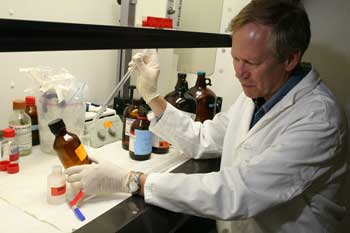Northern Arizona University’s Paul Keim says the genomic analysis that linked the 2001 anthrax letters to the prime FBI suspect who committed suicide last month has generated unprecedented forensic science.
“The scientific advancement represents a large leap forward in our ability to attribute biothreat agents to their source,” Keim said.
Keim joined five other scientists at the FBI headquarters in Washington, D.C., on Monday for two press conferences addressing the science behind the FBI’s investigation into Bruce Ivins, an Army biodefense researcher at the U.S. Army Medical Research Institute for Infectious Diseases in Frederick, Md.
Ivins committed suicide as federal agents were preparing to charge him with carrying out the 2001 anthrax attacks when anthrax spores were sent through the mail, killing five people and sickening 17.
“NAU was one of many laboratories in the United States that was coordinated by the FBI in this highly sophisticated scientific investigation,” said Keim. “New forensic science was developed through this coordinated effort on a scale that had not been achieved previously in any other investigation.
“Genomic analysis has reached new levels of sophistication in the last seven years,” Keim continued. “This led to the most comprehensive description of a pathogen’s genetic material in the history of science. It was crucial in bringing this case near to closure.”
The FBI had subpoenaed 1,070 anthrax samples from throughout the United States and the world, and the Keim Genetics Lab at NAU was one of more than a dozen laboratories that conducted analyses of the samples. Keim’s lab verified the Ames strain of the anthrax samples, which was the strain used in the postal attacks. Keim noted that NAU had one of the few biosafety facilities in the country that could handle such evidence in 2001.
One of the samples the Keim lab investigated included the Ames strain that the FBI scientists had earlier destroyed. That strain pointed investigators to Ivins when they discovered he tried to substitute a different strain in subsequent samples.
The science entailed conducting DNA fingerprinting on an entire anthrax genome. Previous analyses looked at only snippets of DNA. Human genome studies over the last two decades have made the study of complete genomes more economically feasible.
“The more DNA you have, the more information you have to look at,” Keim explained.
The NAU researcher said the forensic science developed in the FBI investigation will result in a “peace dividend.” Keim said, “We will be able to fight common infectious diseases more easily as a result of developing this highly sophisticated DNA fingerprinting.
“Hospital-acquired and food-borne infections will be approached in a different manner involving whole genome analysis,” according to Keim. “We have shown the way forward.”
Keim’s lab has been a critical player in the development of “pathogen fingerprinting” for several years. Key to this was the development by Keim of a relationship in 2002 with the Translational Genomics Research Institute.
Keim directs the Pathogen Genomics research program for TGen, where he established TGen North, a state-of-the-art genomics laboratory in Flagstaff. TGen North’s mission is advancing public health, clinical medicine and biodefense through targeted microbial genomics.
Under Keim’s direction, scientists at TGen North are developing the next generation of molecular tools for biothreat and other disease outbreak investigations.
Several important outcomes have already resulted from TGen North’s work in pathogen genomics research, including the development of new diagnostic tests for influenza, Valley Fever, drug-resistant organisms, like the deadly MRSA (Methicilin-resistant Staphylococcus aureus), and biothreat agents, such as plague and anthrax. TGen North scientists are also developing new ways to explore the complex communities of bacteria and other microbes that are associated with human health and disease.



